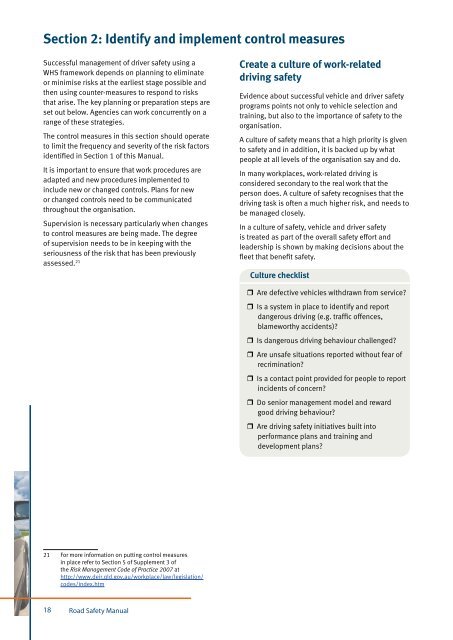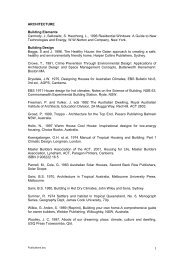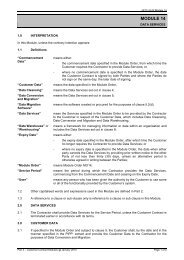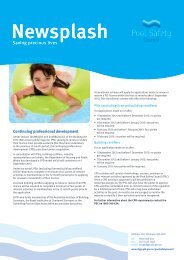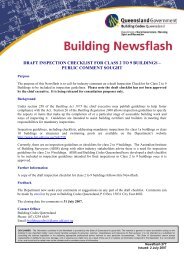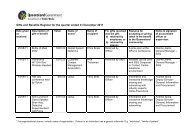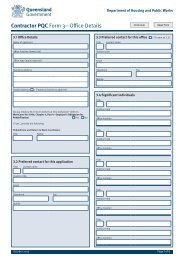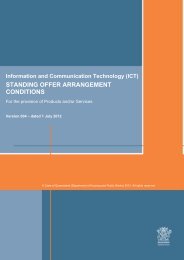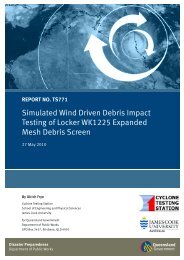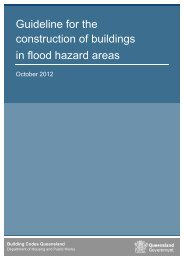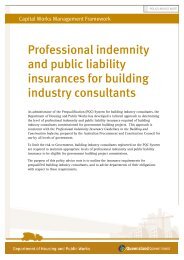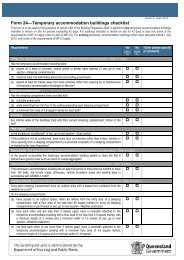QFleet Road Safety Manual - Department of Housing and Public ...
QFleet Road Safety Manual - Department of Housing and Public ...
QFleet Road Safety Manual - Department of Housing and Public ...
You also want an ePaper? Increase the reach of your titles
YUMPU automatically turns print PDFs into web optimized ePapers that Google loves.
Section 2: Identify <strong>and</strong> implement control measures<br />
Successful management <strong>of</strong> driver safety using a<br />
WHS framework depends on planning to eliminate<br />
or minimise risks at the earliest stage possible <strong>and</strong><br />
then using counter-measures to respond to risks<br />
that arise. The key planning or preparation steps are<br />
set out below. Agencies can work concurrently on a<br />
range <strong>of</strong> these strategies.<br />
The control measures in this section should operate<br />
to limit the frequency <strong>and</strong> severity <strong>of</strong> the risk factors<br />
identified in Section 1 <strong>of</strong> this <strong>Manual</strong>.<br />
It is important to ensure that work procedures are<br />
adapted <strong>and</strong> new procedures implemented to<br />
include new or changed controls. Plans for new<br />
or changed controls need to be communicated<br />
throughout the organisation.<br />
Supervision is necessary particularly when changes<br />
to control measures are being made. The degree<br />
<strong>of</strong> supervision needs to be in keeping with the<br />
seriousness <strong>of</strong> the risk that has been previously<br />
assessed. 21<br />
Create a culture <strong>of</strong> work-related<br />
driving safety<br />
Evidence about successful vehicle <strong>and</strong> driver safety<br />
programs points not only to vehicle selection <strong>and</strong><br />
training, but also to the importance <strong>of</strong> safety to the<br />
organisation.<br />
A culture <strong>of</strong> safety means that a high priority is given<br />
to safety <strong>and</strong> in addition, it is backed up by what<br />
people at all levels <strong>of</strong> the organisation say <strong>and</strong> do.<br />
In many workplaces, work-related driving is<br />
considered secondary to the real work that the<br />
person does. A culture <strong>of</strong> safety recognises that the<br />
driving task is <strong>of</strong>ten a much higher risk, <strong>and</strong> needs to<br />
be managed closely.<br />
In a culture <strong>of</strong> safety, vehicle <strong>and</strong> driver safety<br />
is treated as part <strong>of</strong> the overall safety effort <strong>and</strong><br />
leadership is shown by making decisions about the<br />
fleet that benefit safety.<br />
Culture checklist<br />
Are defective vehicles withdrawn from service?<br />
Is a system in place to identify <strong>and</strong> report<br />
dangerous driving (e.g. traffic <strong>of</strong>fences,<br />
blameworthy accidents)?<br />
Is dangerous driving behaviour challenged?<br />
Are unsafe situations reported without fear <strong>of</strong><br />
recrimination?<br />
Is a contact point provided for people to report<br />
incidents <strong>of</strong> concern?<br />
Do senior management model <strong>and</strong> reward<br />
good driving behaviour?<br />
Are driving safety initiatives built into<br />
performance plans <strong>and</strong> training <strong>and</strong><br />
development plans?<br />
21 For more information on putting control measures<br />
in place refer to Section 5 <strong>of</strong> Supplement 3 <strong>of</strong><br />
the Risk Management Code <strong>of</strong> Practice 2007 at<br />
http://www.deir.qld.gov.au/workplace/law/legislation/<br />
codes/index.htm<br />
18 <strong>Road</strong> <strong>Safety</strong> <strong>Manual</strong>


